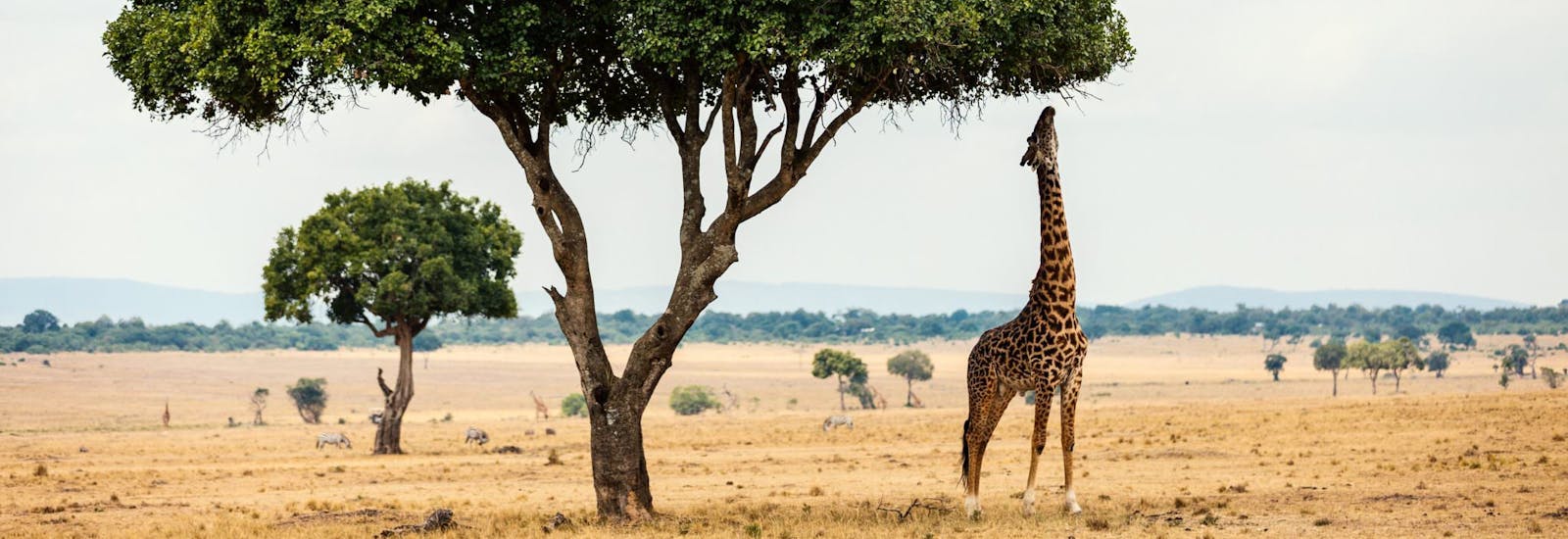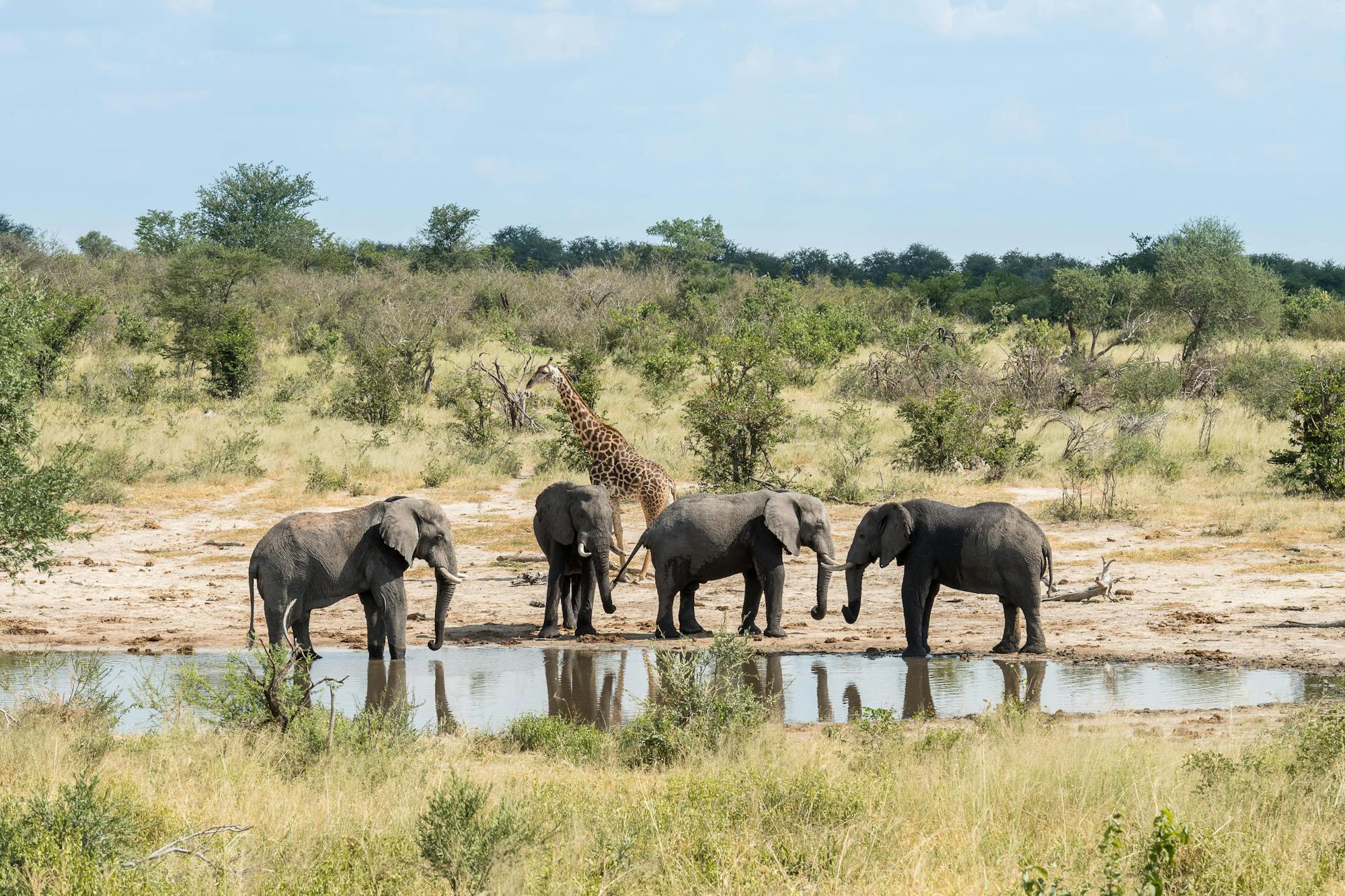
Conserving African giraffes is a tall order - here's how you can help
The African Giraffe is in trouble, yet we only noticed this recently. We need to pay more attention to giraffe and giraffe habitats by monitoring their movements and habits – you can join this effort in Botswana by volunteering with our Okavango Wilderness Experience.
Are giraffes endangered?
If the African savannah were a classroom of schoolchildren, then the giraffe would be the tall, somewhat awkward, quiet kid. The kid everyone knows, but no one really knows much about. For African giraffes, this ‘quiet kid’ status has led to their rapid and alarming decline going largely unnoticed, until very recently. In 2010, they were classified as “Least Concern” by the International Union for the Conservation of Nature (IUCN); only in 2016 did we finally realise that their numbers had dropped by 40%, which led to their re-classification as “Vulnerable”.
Despite being one of the largest and most conspicuous animals in Africa, scientists still cannot agree on exactly how many types of giraffe there are in Africa but have temporarily settled on nine subspecies. These subspecies live in different parts of Africa and therefore face different threats. In Central Africa and the Sudan’s, these peaceful animals are casualties of human civil wars, as roving armed forces kill them for meat. In East and West Africa, increasing human populations have led to people converting giraffe habitat into farmland, and poaching along the boundaries of National Parks is a continual threat. In southern Africa, giraffes have fared better due to a combination of large numbers of small private game reserves, and a few large protected areas that are recognised as globally important “strongholds” for many species, including giraffes. Although concerted conservation efforts have halted the decline of giraffe in some countries, it was nearly too little, too late, as three subspecies comprise less than five hundred animals each.
Giraffe in the Okavango Delta Ecosystem
The type of giraffe occurring in southern Africa, officially known as the Angolan giraffe, is the only subspecies that is still listed as “Least Concern” by the IUCN. With a healthy, increasing population of over 11,000 animals, this subspecies accounts for 14% of all giraffes in Africa. Nevertheless, conservationists in southern Africa cannot afford to be complacent about the status of giraffes in this region. Even in the vast wilderness of the Okavango Delta, giraffe populations crashed by two-thirds, according to an aerial count of wildlife in 2011. Since then, aerial surveys in 2014 revealed that numbers had improved slightly, and between 2014 and 2018 this population has stabilised. The current estimate for giraffes in northern Botswana is over 8,000, which means that this area contains around 70% of all Southern African (or Angolan) giraffes and 12% of all the giraffes in Africa.
The state of African giraffe populations caused the lead researcher in our Okavango Wilderness Experience project to start a project to specifically monitor the local giraffe population. The area covered in this project is an ideal giraffe habitat – mixed savannah woodland – where the trees provide them with plenty of food in the form of leaves.
Another interesting feature of this part of the Okavango Delta is that the natural pans, which are the only source of water in this otherwise very dry area, dry up on a seasonal basis. Although the central parts of the Delta are known to be watery wonderlands year-round, this study site is some distance from the perennial rivers and floodplains. The lack of permanent water to drink may seem to be a bad thing, but it gives the giraffe an advantage over a big competitor for food – the elephant.
Elephants can wreak havoc on woodlands during the dry season, as they push over trees to get to the juiciest leaves or supplement their diet with bark by stripping those trees that are left standing. Large numbers of elephants using an area throughout the dry season will mean fewer trees and moisture-filled leaves for the giraffe. But the giraffe has a card up his sleeve: unlike elephants, which need to drink frequently, the giraffe is so good at conserving water that it can go for months without drinking. So when the water pans dry up in our study area, the elephants are forced to move back to the wetter parts of the Okavango ecosystem, whilst the giraffe can stay and eat their leaves in relative peace and quiet. I say ‘relative’ because the African savannah is never entirely peaceful – the resident lions are also hungrier in the dry season, which means that giraffes may climb to the top of their menu! Although giraffes may not enjoy being on the lion’s menu, their continued presence here is vital for these big cats, as their other preferred prey species (e.g. buffalo and zebra) move back to the wet areas when the natural pans dry up.

Giraffe conservation efforts in their natural habitat
What is happening to African giraffe calls for a more concerted effort to monitor them than we have made in the past. Giraffes are usually counted as part of flying or driving surveys that are used to count all other antelope species and other large animals like elephants. However, these counts do not reveal much about what habitat the giraffe prefer at different times of the year, whether individuals stay in one area or move away over time, and how different giraffe group together at different times. We can only obtain this sort of detailed information by identifying individual animals and recording where and when we see those same animals over time. Thankfully, individual giraffes can be identified using their unique coat patterns.
By joining our Okavango Wilderness Experience research team, you can be part of this African giraffe monitoring effort. First, a photo library of known giraffes is created by collecting clear photos of both sides of each animal along with the location, date, and time they were taken. The next time someone goes out and photographs a giraffe, we can compare the new photos with the ones in the photo library to find out if this is a known giraffe or a new one. Over time, we will come to know most of the resident giraffes in the area, and be able to show where they go and which other giraffes they associate with. We can also figure out if the population is growing through births or immigration, or declining through deaths or emigration.
This information will improve our understanding of giraffe ecology and conservation needs in the dry areas surrounding the Okavango Delta ecosystem. If we can identify the specific conditions that lead to either increases or decreases in this population, we could use this information to figure out what is happening to giraffes living in similar habitats across northern Botswana. By monitoring these animals in greater detail and over longer periods, we can identify any particular threats to them and recommend targeted conservation actions to prevent any further declines. While the giraffe population in northern Botswana appears to have stabilised for now, we need to remain vigilant through constant monitoring.
Your contribution to the giraffe monitoring effort will be to take good photos of any giraffe you encounter. If the giraffe you photograph is not yet on the database, then your photos will help create the identification kits (identikits) for each giraffe. For giraffes that have already been identified, you may try your hand at figuring out which one you have photographed by comparing your photos to the existing identikits – it takes a sharp eye to tell one giraffe apart from another!
All of the information you collect and photos you take will be used to establish where individual giraffes are going, which other giraffe they group with, and whether individuals are moving in or out of the study area over time. Overlaid with information on rainfall and other factors, this information will help build a complete picture of giraffe ecology. Together, we can start paying more attention to this tall, awkward ‘kid’, to figure out what is going on and how we can help.

